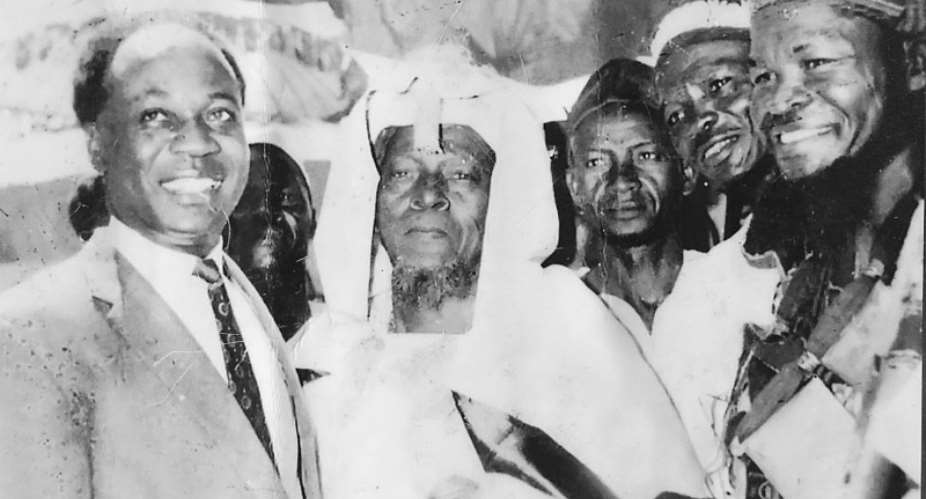The Nayiri Naa Sheriga Abdulai, father of the reigning Nayiri, Naa Bohagu Abdulai Mahami Sheriga, reigned as the king of Mamprugu between 1947-1966. The reign of Naa Sheriga witnessed the struggle for independence from the British by the pioneer politicians of the Gold Coast.
One important part of Ghana's eastern belt, which shares borders with the Republic of Togo, formerly called the British Togoland, included the Pusiga, Garu, Tempani, Bunkpurugu-Nakpanduri, and Yunyoo-Nasuani districts of the Upper East and North East regions, respectively.
In 1884, the German Empire created the protectorate of Togoland. The protectorate had a golden age under German rule and was seen as a model colony, or Musterkolonie. In 1914, Britain and France invaded the protectorate as part of the First World War. The western portion of Togoland became British Togoland, a British mandate, and the eastern portion became French Togoland following the German defeat and the signing of the Treaty of Versailles.
After the Second World War, British Togoland became a United Nations Trust Territory that was under British administration. During the struggle for independence, Naa Sheriga petitioned the United Nations in 1949 during the British Togoland disputes, arguing forcefully that the following twelve (12) places, including Pusiga, Worikambo, Tempane, Nakpanduri, Gbankooni, Bunkpurugu, Gbankurugu, Yunyoo, Temaa, Bimbagu, Binde, and Gbangdaa, belonged to his kingdom and should become part of the Gold Coast upon independence.
The Nayiri emphasizes how our shared culture unites us and how these places, beginning with Pusiga (our ancestral home), were a part of his realm long before the Europeans arrived.
In response to the petition, the Nayiri Naa Sheriga Abdulai sent Hon. Idana (Yidana) Asigri, a Mamprusi prince of Worikambo and the son of Worikam-Daan Asigri, to the UN General Assembly in 1954. There, he made a compelling argument for the communities in question to remain a part of the Gold Coast following independence.
In response to the petitions, the UN dispatched a mission to revisit the regions in 1955 in order to reassess the issues. Interestingly and crucially, there had been a lot of rain and the stream was flooded when the UN team arrived in the Tempane district. But then, as the report describes, CPP activists Amadu Seidu and Tempane Naaba "forded the swollen stream" to inform the UN delegation that they wanted to be a part of the Gold Coast because of their allegiance to the Bawku Naaba and the Nayiri.
Prior to granting independence to Ghana, there was a plebiscite for the people of British Togoland to vote on whether or not they wanted to be part of Ghana. In the 1956 British Togolese status plebiscite, 58% of the western Togolese voted to integrate into what would become independent in 1957.
The Mamprugu land in British Togoland voted massively in favor of their inclusion into the yet-to-be-independent Ghana in support of their king, the Nayiri Naa Sheriga Abdulai. Prior to the plebiscite, Sakogu in the East Mamprusi Municipality and Bawku were the borders of the then-Northern Territory/Gold Coast. Pusiga through to Garu, Tempani, Nakpanduri, Gbankooni, Bunkpurugu, Yunyoo, etc. were part of British Togoland and would have been in the Republic of Togo if Naa Sheriga had not protested that move.
It's funny that people who had no knowledge of the pre-independence struggle are now saying that the land the Nayiri fought for to be added to Ghana is not under his jurisdiction again, given how hard he worked to ensure that his land in then-British Togoland was added to Ghana.
Nayiri deserves to be honored by the government of Ghana for his role in Ghana's independence. It was the petition and counter-petition by the Nayiri to the United Nations Assembly that led to the plebiscite that added the British Togoland to Ghana. While other chiefs called on their subjects to vote against the inclusion of British Togoland in Ghana, the Nayiri admonished his subjects to vote in favor of its inclusion. This is evident from the results of the plebiscite.
In the backdrop of the above-stated historical facts, it was very shocking to hear President Akufo-Addo say that Bawku belongs to the Kusasi, including Pusiga, Worikambo, Tempani, Garu, etc. It is either the president was ill-informed or he was on a delusional ploy to denigrate the high office of the Nayiri, and should be condemned by all well-meaning Ghanaians and civil society organizations that abhor the African Chieftaincy institution.
Story by Badigamsira Inusah Abdul Majeed
Email: [email protected]






 Let’s be true believers, not just church goers – Catholic Priest to Christians
Let’s be true believers, not just church goers – Catholic Priest to Christians
 Ejisu by-election: "We don’t need an independent candidate" — Akufo-Addo fights ...
Ejisu by-election: "We don’t need an independent candidate" — Akufo-Addo fights ...
 Election 2024: Bawumia dares Mahama to two-man debate as he starts countrywide t...
Election 2024: Bawumia dares Mahama to two-man debate as he starts countrywide t...
 'Borla' BVDs: 'Why would anyone want to buy 10 used biometric devices 'hard-code...
'Borla' BVDs: 'Why would anyone want to buy 10 used biometric devices 'hard-code...
 Professor Jane Naana pays last respect to Modestus Ahiable
Professor Jane Naana pays last respect to Modestus Ahiable
 IT is a major skill needed for the job market - Industry Players
IT is a major skill needed for the job market - Industry Players
 Nungua Traditional Council performs “Jenten Nishwamo” ahead of Homowo
Nungua Traditional Council performs “Jenten Nishwamo” ahead of Homowo
 Tema residents demand end of dumsor
Tema residents demand end of dumsor
 A vote for Owusu Aduomi is a vote gor NDC – Bawumia tells Ejisu residents
A vote for Owusu Aduomi is a vote gor NDC – Bawumia tells Ejisu residents
 S. Africa's ex-president Zuma makes surprise comeback
S. Africa's ex-president Zuma makes surprise comeback
